The Influence of the Structure Parameters on the Mechanical Properties of Cylindrically Mapped Gyroid TPMS Fabricated by Selective Laser Melting with 316L Stainless Steel Powder
Abstract
:1. Introduction
2. Materials and Methods
2.1. Theoretical Background
2.2. Gyroid Lattice Structure Design
- Network structure (for e = 1), which contains two continuous regions of space (solid and void) separated by isosurface (U = 0);
- Matrix structure (for e = 2), which contains three regions (a wall of solid material bounded by two unconnected void regions). This type of structure has also been referred to as “shell”, “sheet”, “strut”, or “cellular” in the literature.
2.3. Powder Characterization and Sample Fabrication
2.4. Quasi-Static Cmompession Test
3. Results and Discussion
3.1. Compression Test Results
3.2. Energy Absorption
3.3. Compressive Deformation Behavior
- A variant with complete densification of collapsing layers. In this case, the oscillations in the plateau region of stress–strain curve were observed (Figure 15B). Maximums and minimums in the raising region of the efficiency–strain curve indicate the moment of densification of the layer. This variant of “layer-by-layer” deformation mode was observed for Gyroid_6_1_20_0.87 (Figure 15A);
- A variant with incomplete densification of simultaneously or successively collapsing layers. In this case, no oscillation in the plateau region of the stress–strain curve was observed (Figure 16B). In the course of raising the region of the efficiency–strain curve, there were no maximums and minimums. There is also no clear maximum at the densification point (Figure 13). This variant of “layer-by-layer” deformation mode was presented for an example of Gyroid_6_2_20_0.73 (Figure 16A).
4. Conclusions
- An increase in the number of unit cells in the radial direction (nradial) causes appearances oscillations in the plateau region;
- For samples with nradial = 2, reducing the number of unit cells in circumference direction (ncircum) and thus increasing the wall thickness (T) causes a decrease in the amount and intensity of the oscillations;
- for samples with nradial = 1 and nradial = 1.5, a relatively flat course of the plateau area was observed.
- An increase in the number of unit cells in the circumferential direction (ncircum) causes an increase in the value of EL, σy, σL;
- A decrease in the number of unit cells in the radial direction (nradial) causes an increase in the value of EL, σy, σL.
- For samples with nradial = 1.5 i nradial = 2, an increase in the number of unit cells in the circumferential direction (ncircum) causes an increase in the value of total energy absorption per unit volume up to the densification point;
- for samples with nradial = 1, there is no such clear relationship; however, the sample with ncircum = 6 absorbed the least amount of energy;
- for samples with ncircum = 9 and ncircum = 6, a decrease in the number of unit cells in the radial direction (nradial) causes an increase in the value of total energy absorption per unit volume up to the densification point;
- for samples with ncircum = 12, there is no such clear relationship.
- Increasing the range of variability of design parameters (nradial and ncircum);
- Analysis of the impact of changing the internal diameter;
- Analysis of the effect of changing the number of unit cells (layers) in the axial direction (naxial);
- Analysis of the effect of the gradient of the wall thickness change in the axial direction.
Supplementary Materials
Author Contributions
Funding
Institutional Review Board Statement
Informed Consent Statement
Data Availability Statement
Conflicts of Interest
References
- Zaharin, H.A.; Rani, A.M.A.; Azam, F.I.; Ginta, T.L.; Sallih, N.; Ahmad, A.; Yunus, N.A.; Zulkifi, T.Z.A. Effect of Unit Cell Type and Pore Size on Porosity and Mechanical Behaviour of Additively Manufactured Ti6Al4V Scaffold. Materials 2018, 11, 2402. [Google Scholar] [CrossRef] [Green Version]
- Bandyopadhayay, A.; Espana, F.; Balla, V.K.; Bose, S.; Ohgami, Y.; Davies, N.M. Influence of porosity on mechanical properties and in vivo response of Ti6Al4V implants. Acta Biomater. 2010, 6, 1640–1648. [Google Scholar] [CrossRef] [Green Version]
- Yan, C.; Hao, L.; Hussein, A.; Yaoung, P. Ti-6Al-4V triply periodic minimal surface structures for bone implants fabricated via selective laser melting. J. Mech. Behav. Biomed. Mater. 2015, 51, 61–73. [Google Scholar] [CrossRef] [Green Version]
- Yuan, L.; Ding, S.; Wen, C. Additive manufacturing technology for porous metal implant applications and triple minimal surface structures: A review. Bioact. Mater. 2019, 4, 56–70. [Google Scholar] [CrossRef]
- Yang, E.; Leary, M.; Lozanovski, B.; Downing, D.; Mazur, M.; Sarker, A.; Khorasani, A.M.; Jones, A.; Maconachine, T.; Bateman, S.; et al. Effect of geometry on the mechanical properties of TI-6Al-4V Gyroid structures fabricated via SLM: A numerical study. Mater. Des. 2019, 184, 108165. [Google Scholar] [CrossRef]
- Feng, J.; Fu, J.; Yao, X.; He, Y. Triply periodic minimal surface (TPMS) porous structures: From multi-scale design, precise additive manufacturing to multidisciplinary applications. Int. J. Extrem. Manuf. 2022, 4, 022001. [Google Scholar] [CrossRef]
- Yanez, A.; Cuadrado, A.; Martel, O.; Alfonso, H.; Monopoli, D. Gyroid porous titanium structures: A versatile solution to be used as scaffold in bone defect reconstruction. Mater. Des. 2018, 140, 21–29. [Google Scholar] [CrossRef]
- Yan, C.; Hao, L.; Hussein, A.; Young, P.; Raymont, D. Advance lightweight 316L stainless steel cellular lattice structures fabricated via selective laser melting. Mater. Des. 2014, 55, 533–541. [Google Scholar] [CrossRef] [Green Version]
- Speirs, M.; Van Hooreweder, B.; Van Humbeeck, J.; Kurth, J.-P. Fatigue behaviour of NiTi shape memory alloy scaffolds produced by SLM, a unit cell design comparison. J. Mech. Behav. Biomed. Mater. 2017, 70, 53–59. [Google Scholar] [CrossRef]
- Sychov, M.M.; Lebedev, L.A.; Dyachenko, S.V.; Nefedova, L.A. Mechanical properties of energy-absorbing structures with triply periodic minimal surface topology. Acta Astronaut. 2018, 150, 81–84. [Google Scholar] [CrossRef]
- Beharic, A.; Egui, R.R.; Yang, L. Drop-weight impact characteristic of additively manufactured sandwich structures with different cellular design. Mater. Des. 2018, 145, 122–134. [Google Scholar] [CrossRef]
- Zhang, L.; Feih, S.; Daynes, S.; Chang, S.; Wang, M.Y.; Wei, J. Energy absorption characteristic of metallic triply periodic minimal surface sheet structures under compressive loading. Addit. Manuf. 2018, 23, 505–515. [Google Scholar] [CrossRef]
- Li, X.; Xiao, L.; Song, W. Compressive behaviour of selective laser melting printed Gyroid structures under dynamic loading. Addit. Manuf. 2021, 46, 102054. [Google Scholar]
- Wong, M.; Owen, I.; Sutcliffe, C.J.; Puri, A. Convective heat transfer and pressure losses across novel heat sinks fabricated by Selective Laser Melting. Int. J. Heat Mass Transf. 2009, 52, 281–288. [Google Scholar] [CrossRef]
- Zhang, X.Y.; Fnag, G.; Zhou, J. Additively Manufactured Scaffolds for Bone Tissue Engineering and the Prediction of heir Mechanical Behaviour: A Review. Materials 2017, 10, 50. [Google Scholar] [CrossRef] [Green Version]
- Wu, T.; Yu, S.; Chen, D.; Wang, Y. Bionic Design, Materials and Performance of Bone Tissue Scaffolds. Materials 2017, 10, 1187. [Google Scholar] [CrossRef] [Green Version]
- Ma, Q.; Tang, Q.; Feng, Q.; Song, J.; Han, X.; Gou, F. Mechanical behaviours and mass properties of bone-mimicking scaffolds consisted of gyroid structures manufactured using selective laser melting. J. Mech. Behav. Biomed. Mater. 2019, 93, 158–169. [Google Scholar] [CrossRef] [Green Version]
- Murr, L.E. Strategies for creating living, additively manufactured, open-cellular metal and alloy implants by promoting osseointegration, osteoinduction and vascularization: An overview. J. Mater. Sci. Technol. 2019, 35, 231–241. [Google Scholar] [CrossRef]
- Dong, Z.; Zhao, X. Application of TPMS structures in bone regeneration. Eng. Regen. 2021, 2, 154–162. [Google Scholar] [CrossRef]
- Elmadih, W.; Syam, W.P.; Maskery, I.; Chronopoulos, D.; Leach, R. Mechanical vibration bangaps in surface-based lattices. Addit. Manuf. 2019, 25, 421–429. [Google Scholar]
- Cooke, S.; Ahmadi, K.; Willerth, S.; Herring, R. Metal additive manufacturing: Technology, metallurgy and modelling. J. Manuf. Process. 2020, 57, 978–1003. [Google Scholar] [CrossRef]
- Bose, S.; Ke, D.; Sahasrabudhe, H.; Bandyopadhayay, A. Additive manufacturing of biomaterials. Prog. Mater. Sci. 2018, 93, 45–111. [Google Scholar] [CrossRef]
- Madrid, A.P.M.; Vrech, S.M.; Sanchez, M.A. Advances in additive manufacturing for bone tissue engineering scaffolds. Mater. Sci. Eng. C 2019, 100, 631–644. [Google Scholar] [CrossRef] [PubMed]
- Mahamoud, D.; Al-Rubaie, K.S.; Elbestawi, M.A. The influence of selective laser melting defects on the fatigue properties of Ti6Al4V porosity graded gyroids for bone implants. Int. J. Mech. Sci. 2021, 193, 106180. [Google Scholar] [CrossRef]
- Gibson, L.J.; Ashby, M.F. Cellular Solids: Structure and Properties; Cambridge University Press: Cambridge, UK; New York, NY, USA, 1997. [Google Scholar]
- Maskery, I.L.; Aboulkhair, N.T.; Aremu, A.O.; Tuck, C.J.; Ashcroft, I.A. Compressive failure modes and energy absorption in additively manufactured double gyroid lattices. Addit. Manuf. 2017, 16, 24–29. [Google Scholar] [CrossRef]
- Yanez, A.; Herrera, A.; Martel, O.; Monopoli, D.; Alfonso, H. Compressive behaviour of gyroid lattice structures for human cancellous bone implant applications. Mater. Sci. Eng. C 2016, 68, 445–448. [Google Scholar] [CrossRef]
- Bobbert, F.S.L.; Lietaert, K.; Eftekhari, A.A.; Pouran, B.; Ahmadi, S.M.; Weinass, H.; Zadpoor, A.A. Additively manufactured metallic porous biomaterials based on minimal surfaces: A unique combination of topological, mechanical, and mass transport properties. Acta Biomater. 2017, 53, 572–584. [Google Scholar] [CrossRef] [Green Version]
- Maskery, I.; Sturm, L.; Aremu, A.O.; Panesar, A.; Williams, C.B.; Tuck, C.J.; Wildman, R.D.; Ashcroft, I.A.; Hague, R.J.M. Insights into the mechanical properties of several triply periodic minimal surface lattice structures made by polymer additive manufacturing. Polymer 2018, 152, 62–71. [Google Scholar] [CrossRef]
- Li, D.; Liao, W.; Dai, N.; Xie, Y.M. Comparison of Mechanical Properties and Energy Absorption of Sheet-Based and Strut-Based Gyroid Cellular Structures with Graded Densities. Materials 2019, 12, 2183. [Google Scholar] [CrossRef] [Green Version]
- Yang, L.; Martens, R.; Ferrucci, M.; Yan, C.; Shi, Y.; Yang, S. Continuous graded Gyroid cellular structures fabricated by selective laser melting: Design, manufacturing and mechanical properties. Mater. Des. 2019, 162, 394–404. [Google Scholar] [CrossRef]
- Shitanaka, A.; Aoki, T.; Yokozeki, T. Comparasion of bucking loads of hyperboloidal and cylindrical lattice structures. Compos. Struct. 2019, 207, 877–888. [Google Scholar] [CrossRef]
- Gu, Y.; Zhang, J.; Chen, L.; Du, B.; Liu, H.; Chen, L.; Li, W.; Liu, Y. Deformation behaviours and energy absorption of auxetic lattice cylindrical structures under axial crushing load. Aerosp. Sci. Technol. 2020, 98, 105662. [Google Scholar] [CrossRef]
- Smeets, B.J.R.; Fagan, E.M.; Matthews, K.; Telford, R.; Murray, B.R.; Pavlov, L.; Weafer, B.; Meier, P.; Goggins, J. Structural testing of a shear web attachment point on a composite lattice cylinder for aerospace applications. Compos. Part B 2021, 212, 108691. [Google Scholar] [CrossRef]
- Cao, X.; Ji, B.; Li, Y.; An, X.; Fan, H.; Ke, L. Multi-failure analyses of additively manufactured lattice truss sandwich cylinders. Compos. Part B 2021, 207, 108561. [Google Scholar] [CrossRef]
- Meng, G.; Ji, B.; Han, H.; Gu, C.; Lin, R.; Peng, F. Design and simulation of an innovative cylinder fabricated by selective laser melting. Chin. J. Aeronaut. 2019, 32, 133–142. [Google Scholar] [CrossRef]
- Wang, Y.; Ren, X.; Chen, Z.; Jiang, Y.; Cao, X.; Fang, S.; Zhao, T.; Li, Y.; Fang, D. Numerical and experimental studies on compressive behavior of Gyroid lattice cyrindricall shells. Mater. Des. 2020, 186, 108340. [Google Scholar]
- Maskery, I.; Ashcroft, I.A. The deformation and elastic anisotropy of new gyroid-based honeycomb made by laser sintering. Addit. Manuf. 2020, 36, 101548. [Google Scholar] [CrossRef]
- Ren, H.; Shen, H.; Ning, J. Effect of Internal Microstructure Distribution on Quasi-Static Compression Behaviour and Energy Absorption of Hollow Truss Structures. Materials 2020, 13, 5094. [Google Scholar] [CrossRef]
- Xia, X.C.; Chen, X.W.; Zhang, Z.; Chen, X.; Zhao, W.M.; Liao, B.; Hur, B. Effects of porosity and pore size on the compressive properties of closed-cell Mg alloy foam. J. Magnes. Alloy. 2013, 1, 330–335. [Google Scholar] [CrossRef] [Green Version]
- 2020 nTopology. Available online: https://ntopology.com/ (accessed on 2 June 2022).
- Material Product Data Sheet, Type 316L Austenic Stainless Steel Powders for Additive Manufacturing, MetcoAddTM 316L-A, Oerlicon Metco. Available online: https://www.oerlikon.com/ecoma/files/DSM-0272_AM_316L-AusteniticSteel.pdf?download=true (accessed on 6 November 2021).
- Laskowska, D.; Mitura, K.; Ziółkowska, E.; Bałasz, B. Additive manufacturing methods, materials and medical applications- the review. J. Mech. Energy Eng. 2021, 5, 15–30. [Google Scholar] [CrossRef]
- ISO 13314; Mechanical Testing of Metals- Ductility testing- Compression Test for Porous and Cellular Metals. International Standard: Geneva, Switzerland, 2011; pp. 1–7.

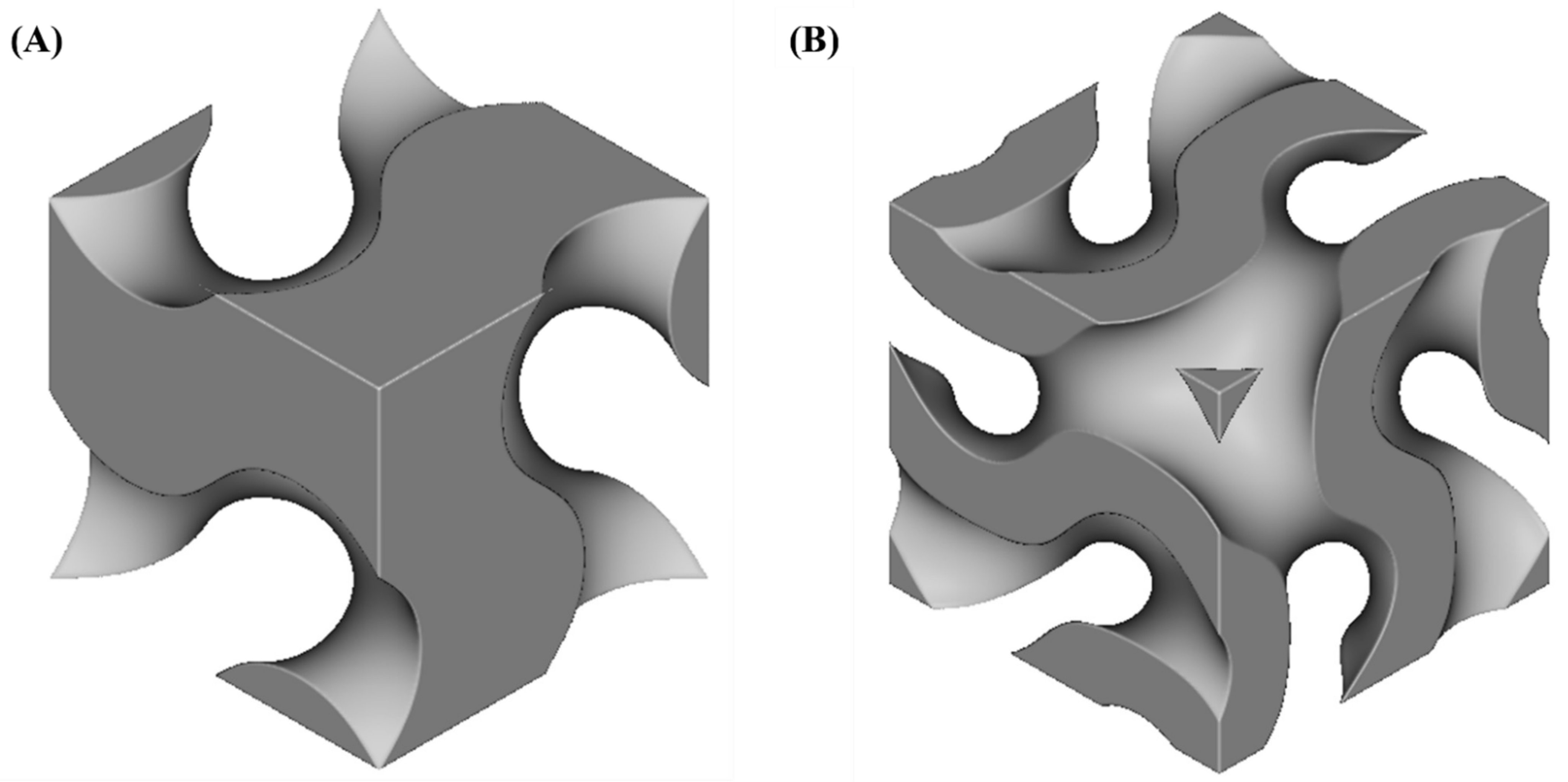
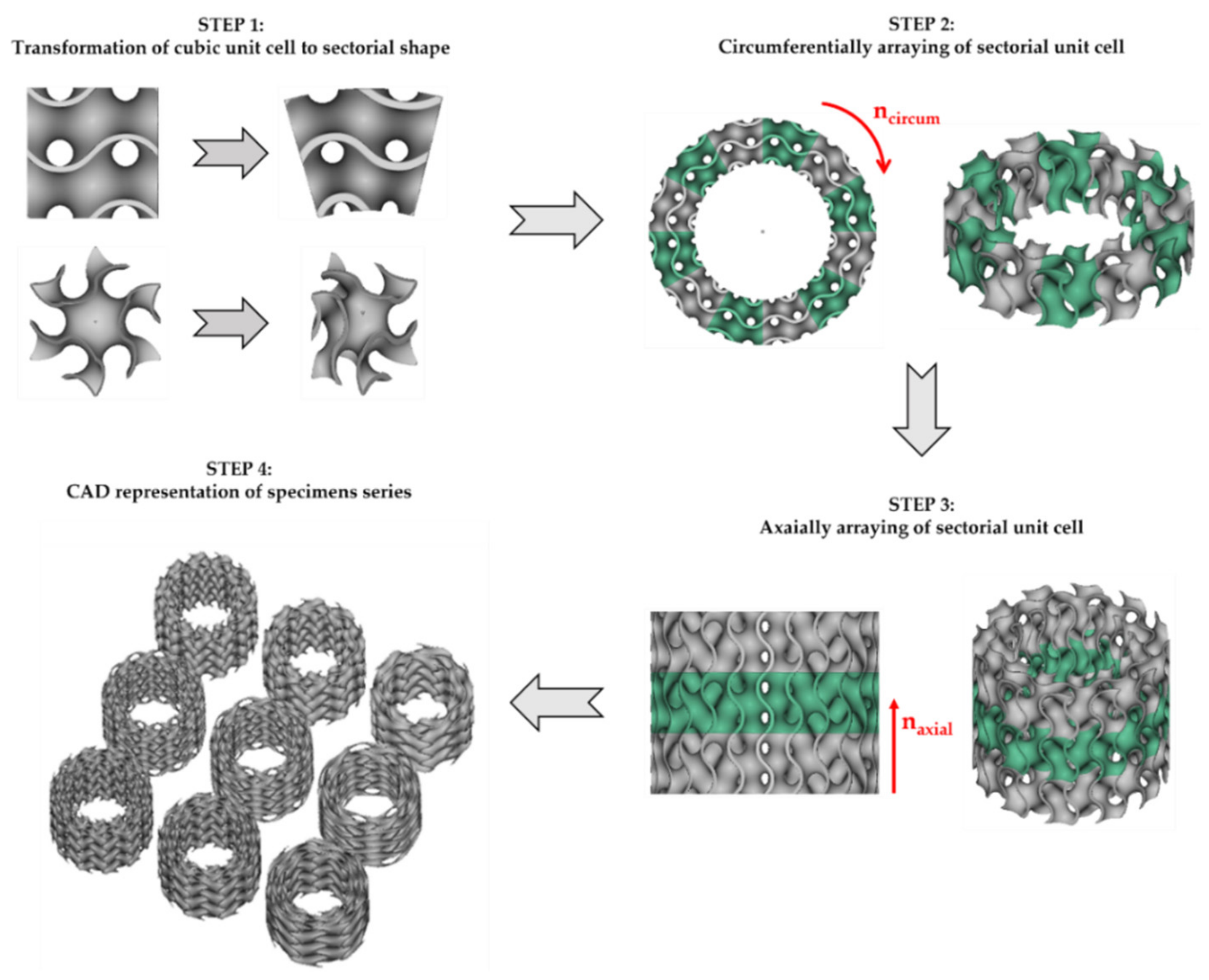
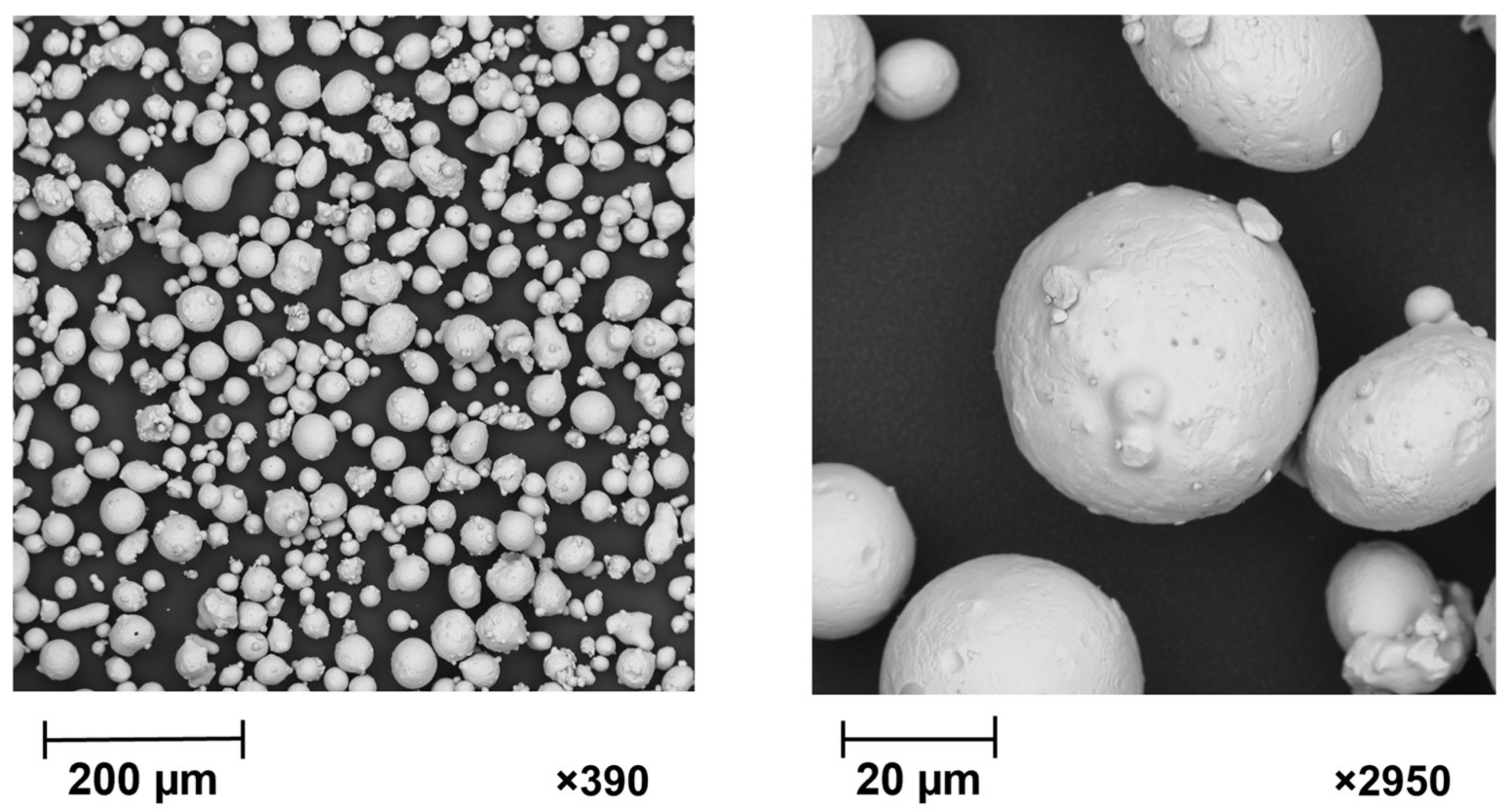
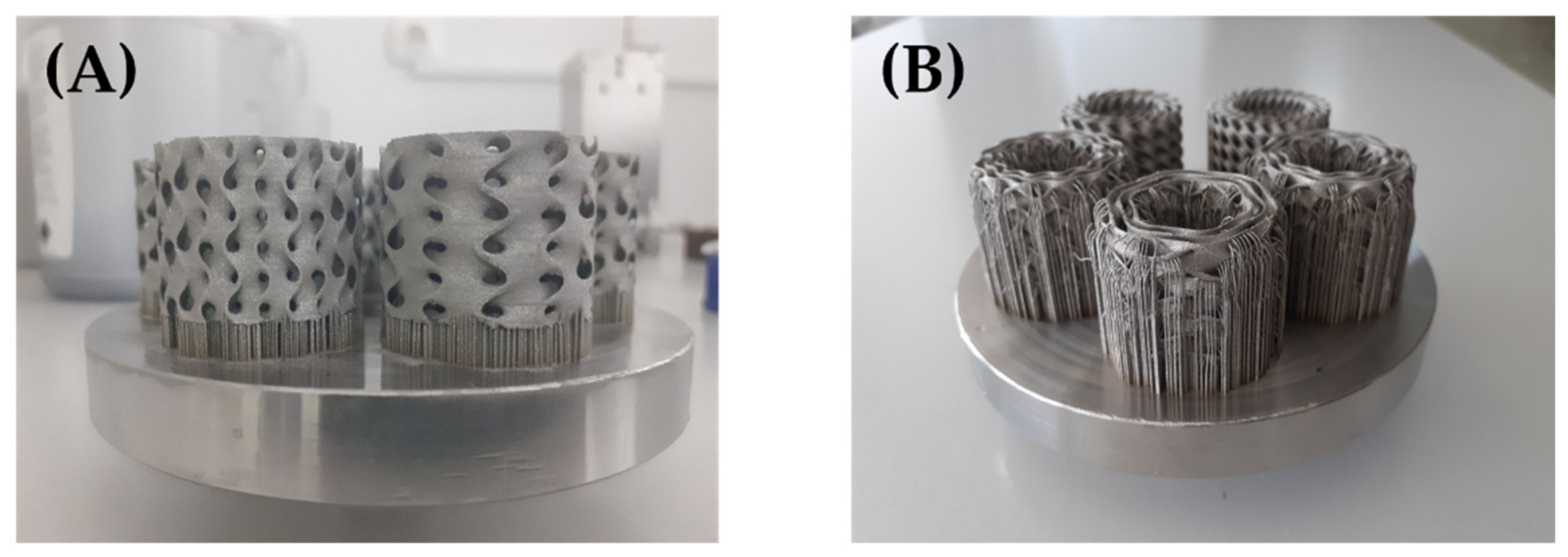
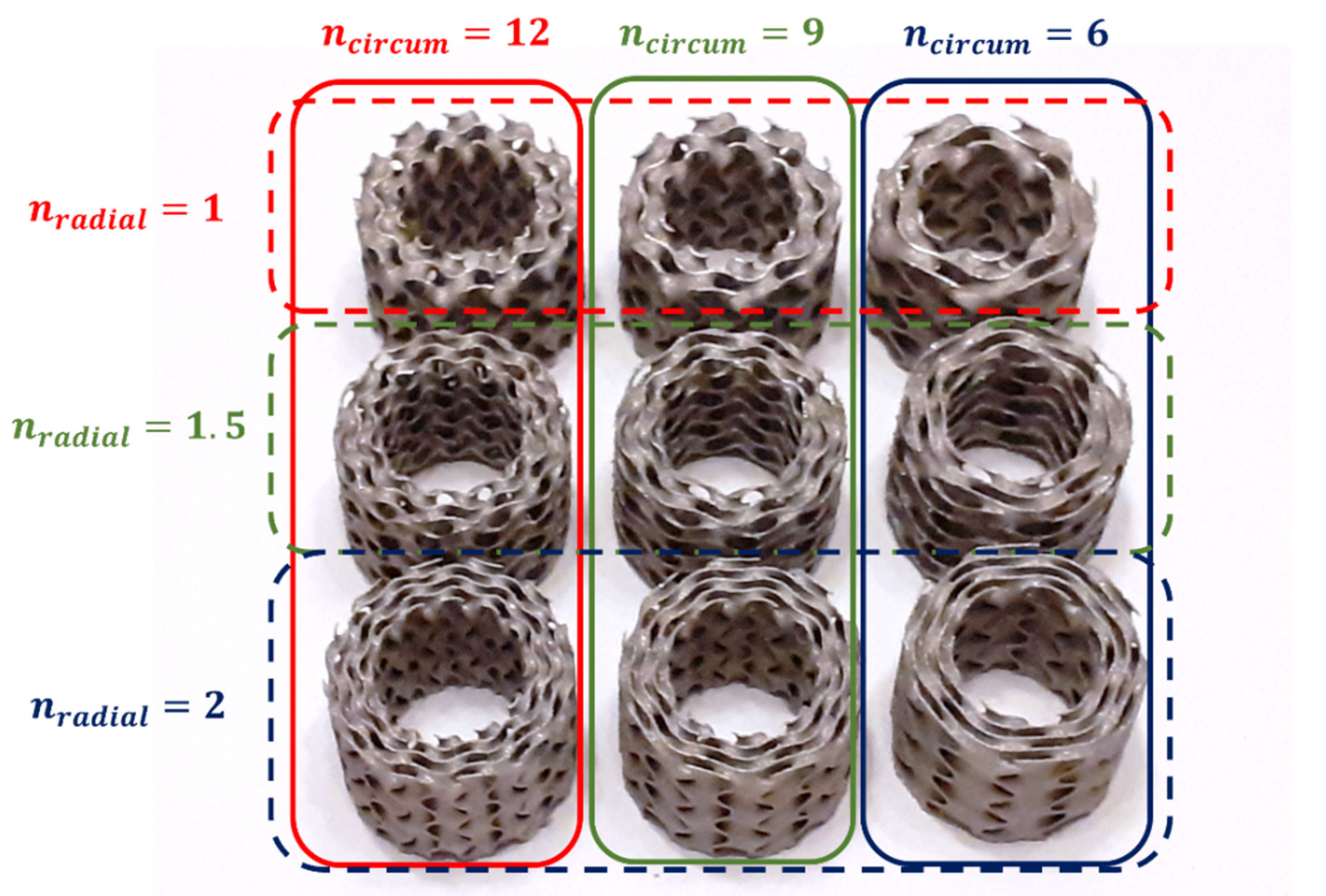
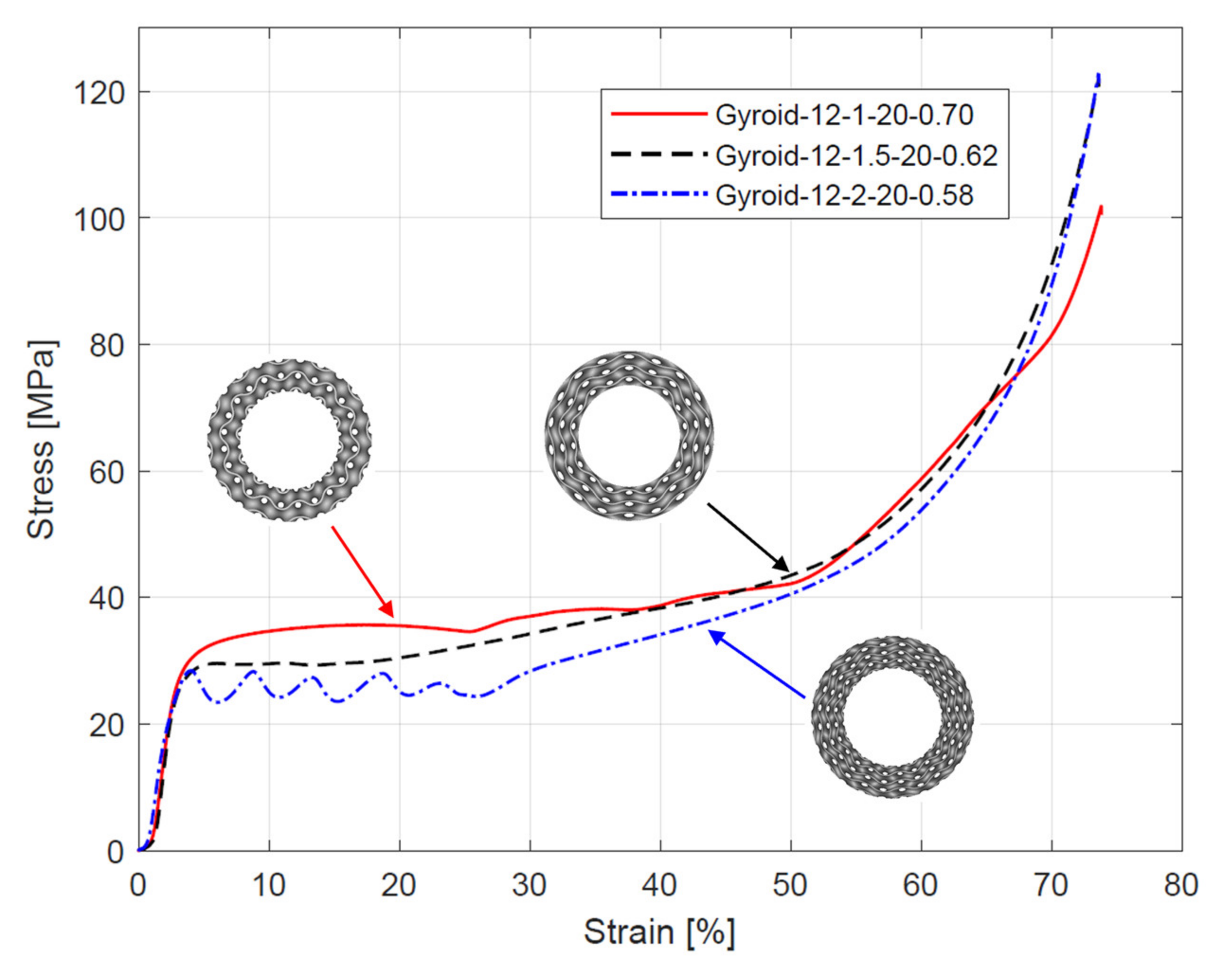


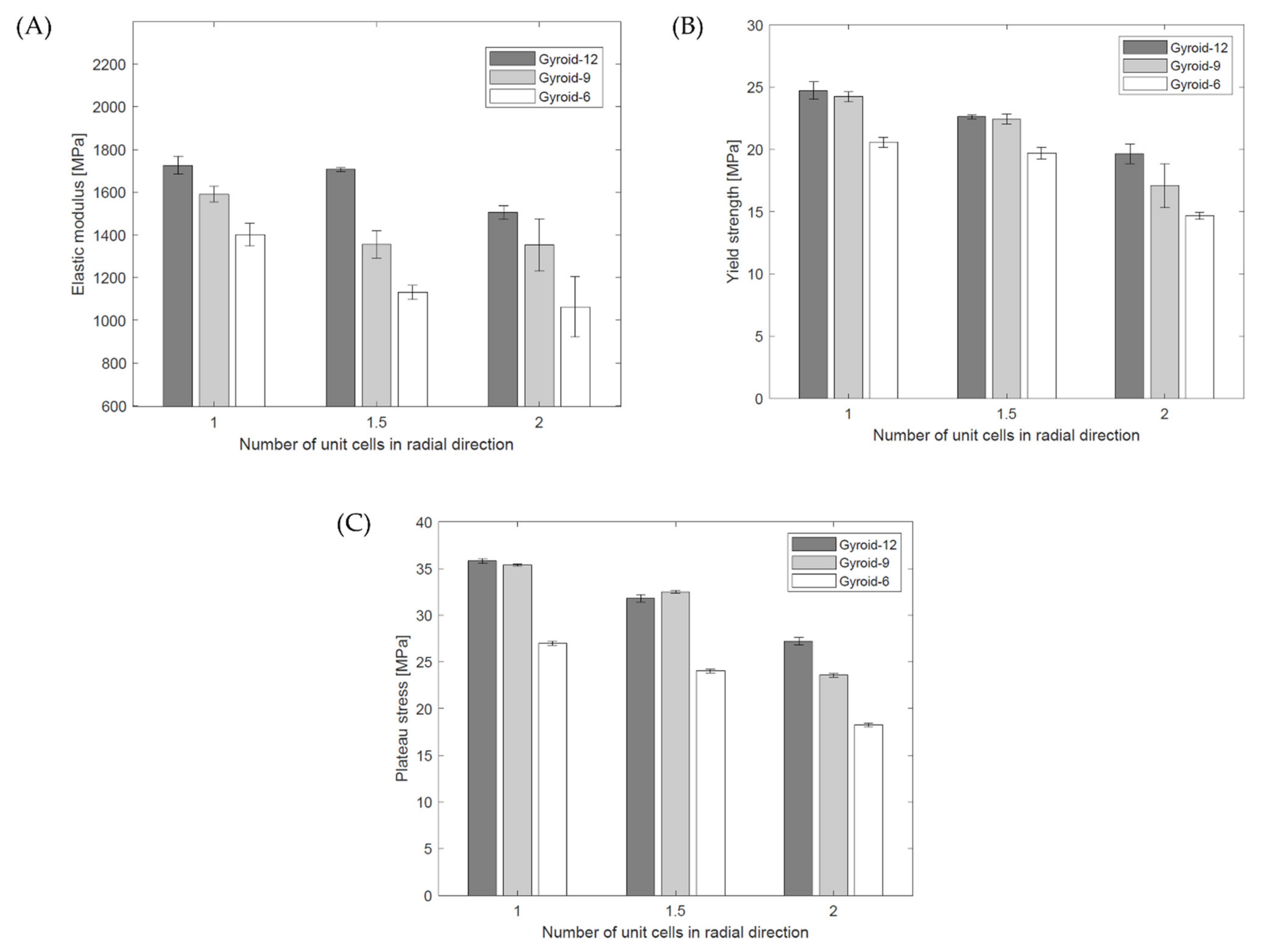


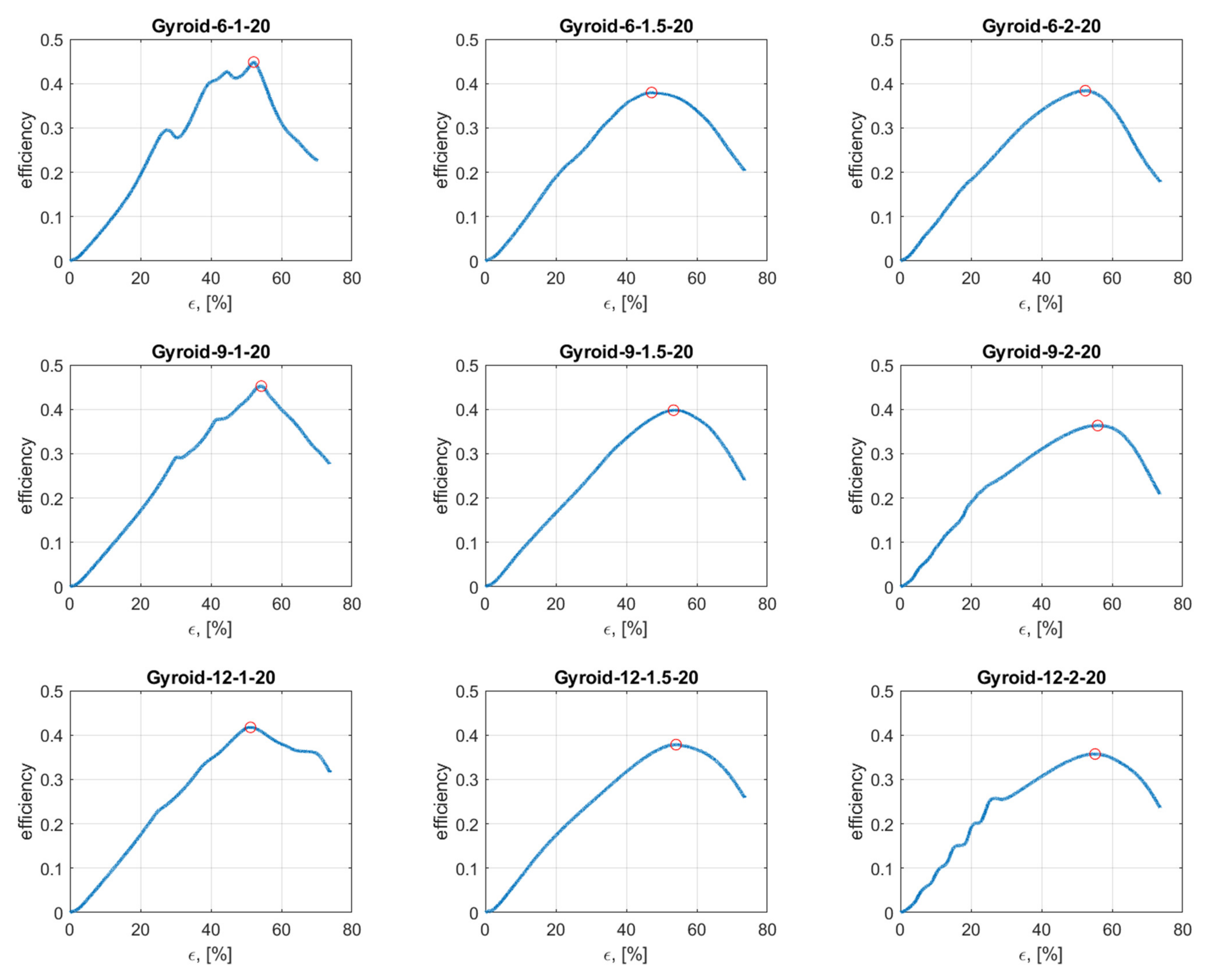


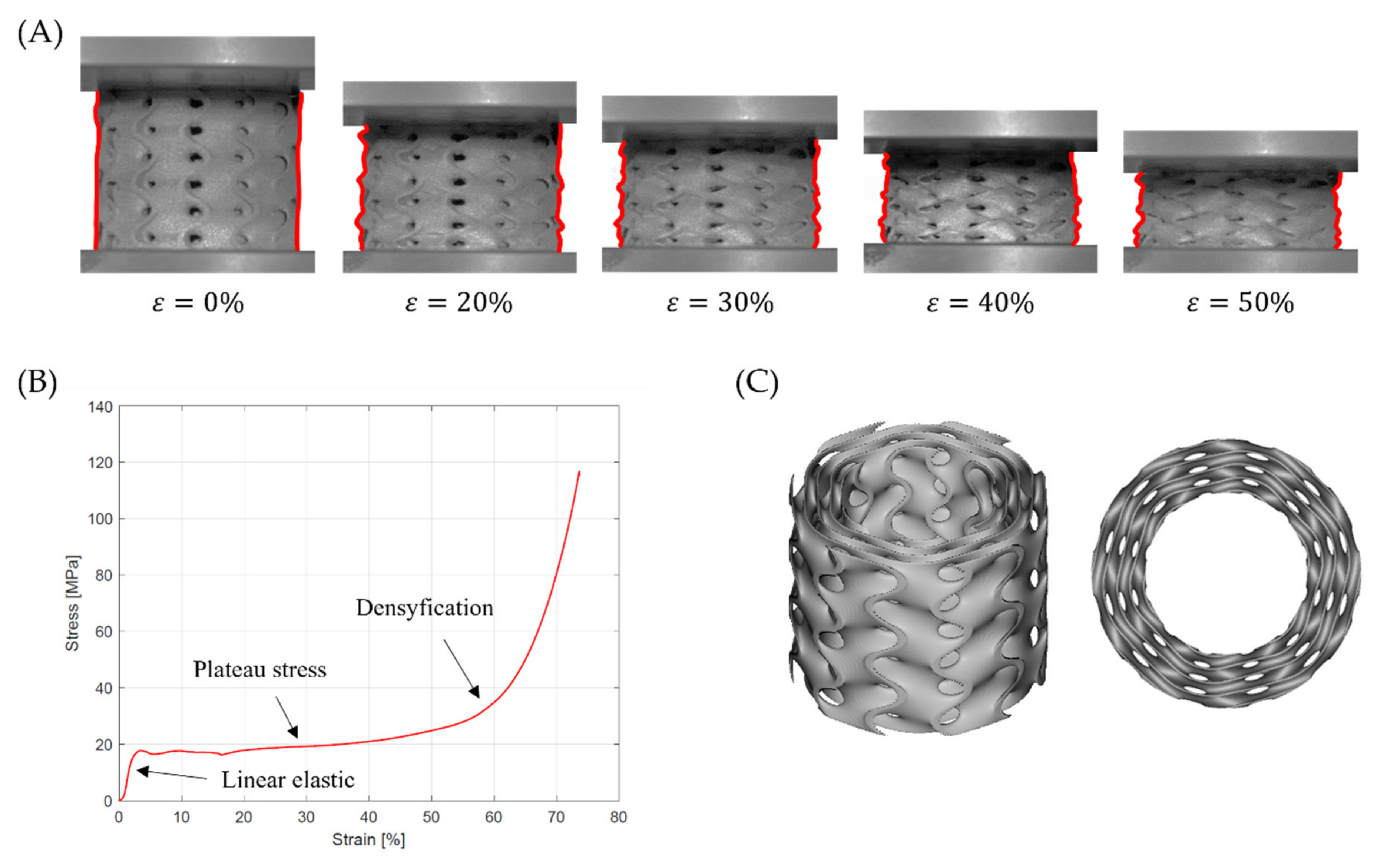
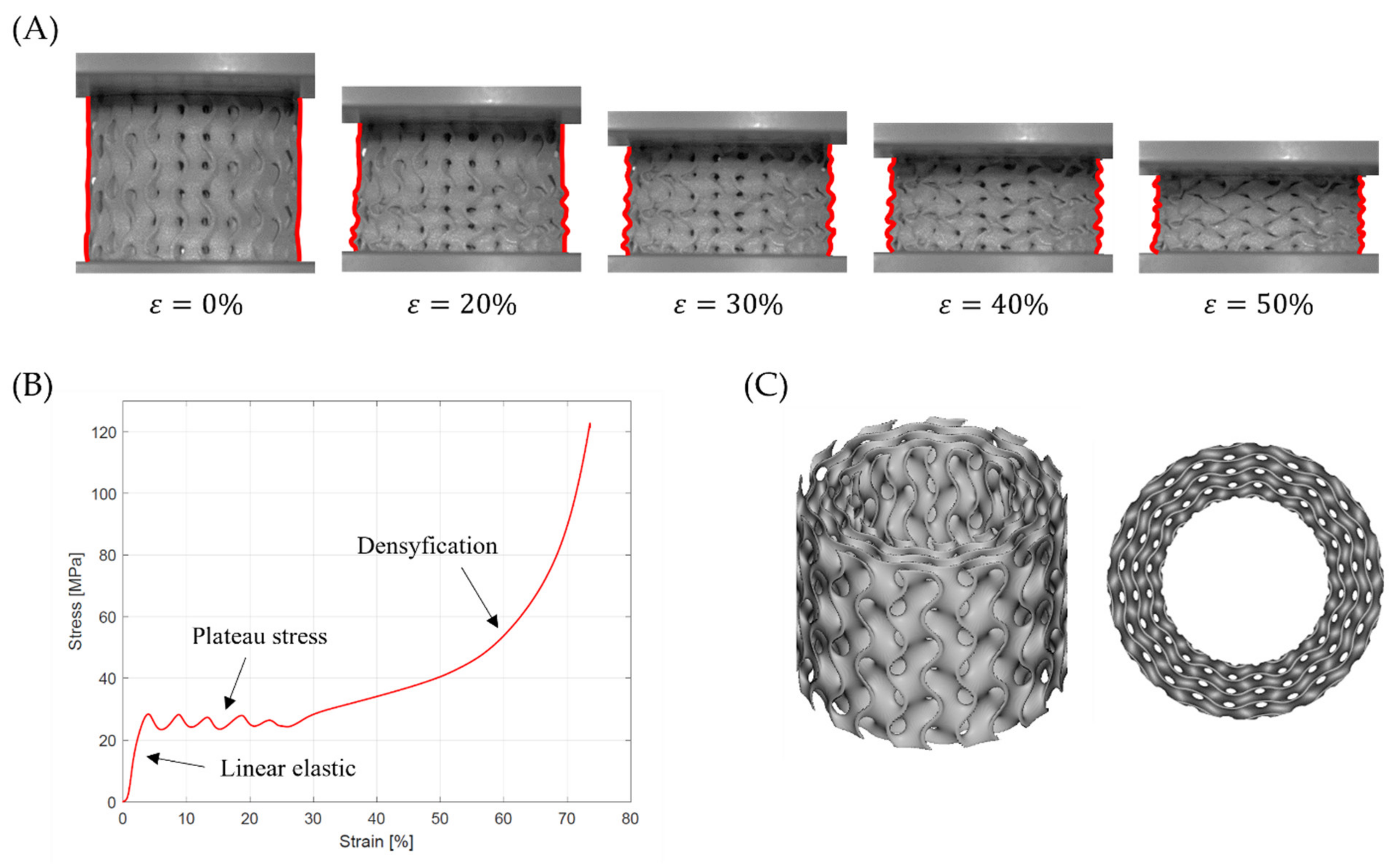
| Element | Fe | Cr | Ni | Mo | C | Other |
|---|---|---|---|---|---|---|
| Weight percent [%] | Balance | 18 | 12 | 2 | <0.03 | <1.0 |
| Laser Power | Laser Speed | Layer Thickness | Printing Environment |
|---|---|---|---|
| 123 W | 1000 mm/s | 25 µm | Argon |
| Symbol | ncircum | nradial | naxial | T [mm] | mr [g] | mr_avrage [g] | Δm [%] |
|---|---|---|---|---|---|---|---|
| Gyroid_12_1_20_0.70 | 16.72 | 16.56 | 0.63 | ||||
| 12 | 1 | 3 | 0.70 | 16.52 | |||
| 16.44 | |||||||
| Gyroid_12_1.5_10_0.62 | 16.26 | 16.32 | −0.83 | ||||
| 12 | 1.5 | 3 | 0.62 | 16.28 | |||
| 16.34 | |||||||
| Gyroid_12_2_20_0.58 | 16.33 | 16.41 | −0.28 | ||||
| 12 | 2 | 3 | 0.58 | 16.46 | |||
| 16.45 | |||||||
| Gyroid_9_1_20_0.77 | 16.72 | 16.60 | 0.87 | ||||
| 9 | 1 | 3 | 0.77 | 16.73 | |||
| 16.86 | |||||||
| Gyroid_9_1.5_20_0.69 | 16.36 | 16.36 | −0.63 | ||||
| 9 | 1.5 | 3 | 0.69 | 16.23 | |||
| 16.48 | |||||||
| Gyroid_9_2_20_0.64 | 16.32 | 16.50 | 0.22 | ||||
| 9 | 2 | 3 | 0.64 | 16.72 | |||
| 16.45 | |||||||
| Gyroid_6_1_20_0.87 | 16.69 | 16.51 | 0.28 | ||||
| 6 | 1 | 3 | 0.87 | 16.45 | |||
| 16.38 | |||||||
| Gyroid_6_1.5_20_0.80 | 16.24 | 16.32 | −0.85 | ||||
| 6 | 1.5 | 3 | 0.80 | 16.24 | |||
| 16.28 | |||||||
| Gyroid_6_2_20_0.73 | 16.47 | 16.58 | 0.71 | ||||
| 6 | 2 | 3 | 0.73 | 16.58 | |||
| 16.68 |
| Symbol | Elastic Modulus [MPa] | Yield Strength [MPa] | Plateau Stress [MPa] |
|---|---|---|---|
| Gyroid_12_1_20_0.70 | 1726.16 ± 42.35 | 24.72 ± 0.69 | 35.80 ± 0.25 |
| Gyroid_12_1.5_20_0.62 | 1706.33 ± 8.69 | 22.61 ± 0.16 | 31.81 ± 0.38 |
| Gyroid_12_2_20_0.58 | 1504.81 ± 32.47 | 19.63 ± 0.80 | 27.20 ± 0.39 |
| Gyroid_9_1_20_0.77 | 1590.91 ± 37.11 | 24.22 ± 0.40 | 35.39 ± 0.12 |
| Gyroid_9_1.5_20_0.69 | 1355.98 ± 64.50 | 22.43 ± 0.40 | 32.51 ± 0.16 |
| Gyroid_9_2_20_0.64 | 1353.19 ± 121.480 | 17.09 ± 1.77 | 23.57 ± 0.18 |
| Gyroid_6_1_20_0.87 | 1401.53 ± 53.57 | 20.57 ± 0.40 | 27.00 ± 0.23 |
| Gyroid_6_1.5_20_0.80 | 1130.34 ± 33.24 | 19.68 ± 0.46 | 24.02 ± 0.19 |
| Gyroid_6_2_20_0.73 | 1063.36 ± 141.04 | 14.67 ±0.27 | 18.24 ± 0.20 |
| Symbol | Densification Point [%] | Total Energy Per Unit Volume [MJ/m3] |
|---|---|---|
| Gyroid_12_1_20_0.70 | 51 | 17.80 |
| Gyroid_12_1.5_20_0.62 | 54 | 17.78 |
| Gyroid_12_2_20_0.58 | 55 | 16.63 |
| Gyroid_9_1_20_0.77 | 54 | 19.26 |
| Gyroid_9_1.5_20_0.69 | 53 | 16.90 |
| Gyroid_9_2_20_0.64 | 56 | 14.76 |
| Gyroid_6_1_20_0.87 | 52 | 13.68 |
| Gyroid_6_1.5_20_0.80 | 47 | 11.21 |
| Gyroid_6_2_20_0.73 | 52 | 9.72 |
| Gyroid_6_1_20_0.87 | Gyroid_6_1.5_20_0.80 | Gyroid_6_2_20_0.73 |
|---|---|---|
 |  |  |
|
|
|
| Gyroid_9_1_20_0.77 | Gyroid_9_1.5_20_0.69 | Gyroid_9_2_20_0.64 |
 |  |  |
|
|
|
| Gyroid_12_1_20_0.70 | Gyroid_12_1.5_20_0.62 | Gyroid_12_2_20_0.58 |
 |  |  |
|
|
|
Publisher’s Note: MDPI stays neutral with regard to jurisdictional claims in published maps and institutional affiliations. |
© 2022 by the authors. Licensee MDPI, Basel, Switzerland. This article is an open access article distributed under the terms and conditions of the Creative Commons Attribution (CC BY) license (https://creativecommons.org/licenses/by/4.0/).
Share and Cite
Szatkiewicz, T.; Laskowska, D.; Bałasz, B.; Mitura, K. The Influence of the Structure Parameters on the Mechanical Properties of Cylindrically Mapped Gyroid TPMS Fabricated by Selective Laser Melting with 316L Stainless Steel Powder. Materials 2022, 15, 4352. https://doi.org/10.3390/ma15124352
Szatkiewicz T, Laskowska D, Bałasz B, Mitura K. The Influence of the Structure Parameters on the Mechanical Properties of Cylindrically Mapped Gyroid TPMS Fabricated by Selective Laser Melting with 316L Stainless Steel Powder. Materials. 2022; 15(12):4352. https://doi.org/10.3390/ma15124352
Chicago/Turabian StyleSzatkiewicz, Tomasz, Dorota Laskowska, Błażej Bałasz, and Katarzyna Mitura. 2022. "The Influence of the Structure Parameters on the Mechanical Properties of Cylindrically Mapped Gyroid TPMS Fabricated by Selective Laser Melting with 316L Stainless Steel Powder" Materials 15, no. 12: 4352. https://doi.org/10.3390/ma15124352
APA StyleSzatkiewicz, T., Laskowska, D., Bałasz, B., & Mitura, K. (2022). The Influence of the Structure Parameters on the Mechanical Properties of Cylindrically Mapped Gyroid TPMS Fabricated by Selective Laser Melting with 316L Stainless Steel Powder. Materials, 15(12), 4352. https://doi.org/10.3390/ma15124352







